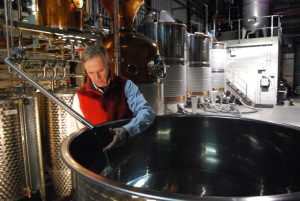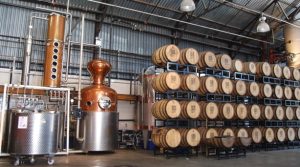In gearing up for the third annual New York Rye Week, Food Karma’s Communications Director, Dylan Heuer, spoke with Tom Potter, the co-founder of New York Distilling Company, about the history of distilling in NYC, his role in founding Empire Rye, and the growing momentum giving new life to this forgotten grain!

Photo by David Loaiza
“In 2008 I was looking around thinking about starting a distillery and at that point, there were no distilleries in the city…But it just felt like something that was ready to happen.”
Dylan Heuer: The history of distilling in New York City goes back hundreds of years, but in the decades since prohibition this local industry nearly vanished. Why did this void exist and what has inspired you to help fill it?
Tom Potter: The history of distilling goes back to the 1600s. The Dutch began distilling possibly as early as the 1640s. And the first known distillery was on Staten Island – which is one of the early small colonies – and then [more followed in] Manhattan and Brooklyn. By the 1700s, they had moved from Dutch to English control and the distilleries in the city made gin – since both the Dutch and the English had traditions of gin making – and also whiskey. The most prominent Brooklyn distillery was down on the Brooklyn waterfront, what’s now Brooklyn Bridge Park. That was the Pierrepont Distillery and they were a whiskey making distillery.
It’s a great history. New York was one of the earliest sites for distilling in the United States. Similar to brewing, we had a very decentralized distillation scene where there were small distilleries all over the place and very few large distilleries. It wasn’t until prohibition that it was shut down. At that point, the small distilleries were mostly closed for good. Between the ‘30s and the ‘60s, there were still a few large distilleries hanging on, but very few. New York city was the corporate headquarters for some conglomerates [but] it didn’t actually do much distilling.
So in 2008 I was looking around thinking about starting a distillery and at that point, there were no distilleries in the city. I knew there were a couple of other folks that were thinking about it, but it was very much an unknown. We didn’t know how the city would react. We knew that permitting and licensing would be a challenge. But it just felt like something that was ready to happen.
“It’s hard to argue that the corn of New York is any better than the corn of Kentucky, but the rye of New York is better.”
Dylan Heuer: Tell me more about how you make whiskey today at NY Distilling. How long have you been open, what equipment are you using, and where do you source ingredients?
Tom Potter: We opened on December 5th, 2011, which was the anniversary of Repeal Day, so it was a happy day for us to open, a happy accident. And our equipment is a Carl Still, [from the] Christian Carl company in Germany. Back then, 2010-11, there were no manufacturers of small stills in the United States because there were no small distilleries. The Christian Carl company was a very old company, a couple hundred years old, and they had survived and thrived making stills for artisan producers in Europe. So it’s a 1,000 liter still. And then we have two 3,000 liter fermenters and a 3,000 liter mash tun. It’s a multipurpose still, kind of like the jack-of-all-trades still, that’s great for gin [and] it’s great for whiskey.
We only make rye whiskey. We decided before we opened that we would focus strictly on ryes. At that time it was pretty unusual because it was a tiny part of the American whiskey scene. It has since grown wonderfully. It’s grown almost ten fold, since 2009. But back when we were planning the distillery, of course we couldn’t know that. We did believe that rye was a very exciting category. It was historically tied to New York and we felt like it was a chance for us to do something that was out of the shadow of the great bourbon distilleries down South, so that we could create our own way and start making spirits that would be unique.
From the start we’ve had a partnership with an upstate farmer named Rick Pedersen and he is one of the more prominent organic farmers upstate. He was one of the very first New York farmers to grow hops again – this was back probably 20 years ago, but he’s always been open to experimentation. So when we started the distillery, I reached out to him and asked him about rye. It turned out that he had been growing rye forever, but that there wasn’t much of a market for it. He just used it as a cover crop, which is especially important in organic farming. For him, the idea of a market for this rye that he had been growing, but just plowing under every year, was delightful. So we’ve been working with him from the start. Our mash bill is now 75% rye, roughly 15% corn and 10% malted barley.

Dylan Heuer: Tell me more about what makes you passionate about rye.
Tom Potter: We believe in rye and that was kind of a lonely place to be back seven, eight years ago. But we really felt rye was a product that New York could do a uniquely great job on. And there’s a couple of reasons. One is that the history of whiskey in America has a lot of different threads, but two of the main ones are bourbon and rye. And as bourbon has become more and more associated with Kentucky and the South, it leaves an opening for those of us in the North to concentrate on rye.
And historically, that’s what we made. New York, Maryland, Pennsylvania – we were rye producing states back in the 1700s and 1800s. It’s our heritage. New York City has a long cocktail history, and rye whiskey was the base for the classic American whiskey cocktails – Old Fashions, Sazeracs and Manhattans.
Finally, from an agricultural perspective, rye grows best in cold climates. Rye loves rocky soil. It likes cold, hard winters. New York is a great place to grow rye. You can grow corn just about anywhere. It’s hard to argue that the corn of New York is any better than the corn of Kentucky, but the rye of New York is better. There’s a connection with the distilling and the agriculture. This is an agricultural product. It’s got seasonality, it has terroir [and] the grain is part of that.
Dylan Heuer: Your commitment to creating a market for New York rye goes beyond your own spirits. Tell me about the impetus for founding Empire Rye.
Tom Potter: It was in 2015, at the American Craft Spirits Association Conference, which was in Denver that year. We were hanging out, the New York distillers, and we started to talk about a rye whiskey. There was a group of us [who] became the six original founders [of Empire Rye]. We agreed a key to the success for New York grown rye whiskey would be to band together and to establish some quality controls and distinctiveness to make sure that New York became known, for not just rye whiskey, but for really great rye whiskey.
So we argue back and forth. The tension was in keeping enough room for creativity and variety, but to demand that the quality be there. We ended up with a few simple rules, which had a profound effect. [We decided Empire Ryes] had to be at least 75% rye in the grain bill, which is important. A lot of the commercial ryes are 51%. rye. So they’re just barely ryes. If they had 2% less, they’d be bourbons. So 75% rye, which has to be New York grown rye. The entry proof has to be not more than 115. And then finally we thought it should be at least two years old so that it could be a straight rye whiskey.
Those were the founding principles after lots of argument back and forth. And we all went back and started to make it. The first Empire Ryes were available exactly two years later. March of 2017, we had our first Empire Rye. Then in 2019, this year, we had our first bottled-in-bond Empire Rye, four years old.
“[Rye whiskey] was historically tied to New York and we felt like it was a chance for us to do something that was out of the shadow of the great bourbon distilleries down South, so that we could create our own way”
Dylan Heuer: How has this label evolved since?
Tom Potter: We started with six distilleries and at that point, we opened it up to any distillery in New York that wanted to become a member of our association. We stressed this was a non-exclusive club, you just had to follow the rules. At our last New York State Distillers Conference, I think there were 19 distillers who had a whiskey laid down that would become Empire, and another four or five distilleries that had committed to do it this year. So as soon as next year, there will be close to 20. And I don’t doubt that a year or two from now, they’ll probably be closer to 30 Empire distilleries.
This was the first effort to define a new state style since Tennessee whiskey. I don’t doubt it’s going to be the last, there’s already been some other States that have warmed to the idea. But this was the first and it got a lot of really nice attention. There were articles in The Times, Whiskey Advocate and others. They’re really treating the idea with interest and respect. We’ve got now a couple dozen distilleries working away on this style; it’s gonna become something and not just in the United States. There’s an opportunity for New York distilleries to really shine; to do something that’s unique and very high quality.
Dylan Heuer: What makes NY Distilling Company’s Empire Rye unique?
Tom Potter: So of our particular whiskeys, there are two that are Empire. One is our applejack finished Ragtime. Our flagship expression, is Ragtime Rye Whiskey. The flagship is a minimum of three years old, but some barrels could be as old as five or six years. So it is not an Empire Rye, because our oldest barrels don’t quite meet the Empire standard. But [using] that as our base, we have two variations on that, which are purely Empire. The first one is our applejack finished Ragtime. That is two to three years old and then we finish it in an applejack brandy barrel. In our case, we’re sourcing those from the Black Dirt Distillery, who are our longtime partners. It’s, at 100 proof, got lots of the spicy rye character that our Ragtime has. It does have the mellow notes from the aging, the caramel and vanilla. But it also has a light green apple on the nose, and it really works well with the rye. It’s sort of the perfect fall whiskey.
Then our most recent Empire expression is Ragtime bottled-in-bond. I love bottled-in-bond as a category. It means it has to be at least four years old and it has to be distilled, aged, and bottled in the same state. Bottled-in-bond is an old fashioned category that dates back to 1897. And it was one of the original consumer protection laws that used to be important and kind of fell off. But my theory is that it’s going to become an increasingly important category for artisan whiskey because there’s a big chunk of whiskey which has artisan looking labels on it, but they’re made at the big factories. You can buy barrels, and bring it to wherever you are, and then put your name on it. If you’re a bottled-in-bond from New York, you know, it’s actually a New York distilled whiskey, not one that’s made in Indiana or Kentucky and then slapped with a New York label. So I think it’s an increasingly important category for artisan producers and it’s also great just as a whiskey style.
Dylan Heuer: This is the third annual NY Rye Week. What are you excited about this year?
Tom Potter: Events like Pastrami on Rye that Jimmy’s producing – I’m really happy that the idea of Rye Week is resonating beyond just New York Distilling. The first year we kind of organized everything and that’s the way anything gets started. Last year it grew, and this year, there is a wider variety of events across the state than ever.
It’s just really exciting to see the idea get picked up by distillers, but then also to get people like Grow NYC really excited about it. We have Nordic cuisine that’s growing. Restaurants like Agern others that are embracing the new Nordic cuisine that’s based around some pretty old ingredients, including rye. There have rye beers, which we didn’t have, except for a few historic examples. So I’m excited that the idea has caught its own fire. It’s expanding organically and I’m excited that it’s really found a resonance in New York state.

